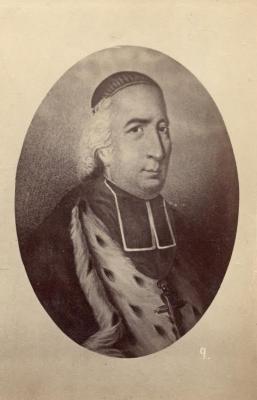President: 1796-1799
Fr. Louis DuBourg, S.S., served as Georgetown's third president from 1796-1799. He sought to expand enrollment and Georgetown's academic offerings, but his lavish spending and conflicts with the Jesuits created challenges for the college. As a member of the Society of Priests of Saint Sulpice, DuBourg was the first non-Jesuit to serve as President of Georgetown.
Early career
As a young child, Fr. Louis Guillaume DuBourg studied in Bordeaux before moving to Paris to study the classics. There he met Jacques-André Emery, the superior general of the Society of Priests of Saint Sulpice. DuBourg was ordained in 1790 and headed a boarding school in Issy, France before the rise of the Jacobins forced him to flee. He fled first to Spain and then Baltimore in 1794. On October 1, 1796, Fr. DuBourg replaced Fr. Molyneux and became Georgetown’s third president.1
Expansion efforts
Fr. DuBourg prioritized the transformation of the “Georgetown Academy” into “Georgetown College.” He adopted the Georgetown seal and made uniforms standard wear, with blue coats and red waistcoats for Sundays and formal occasions. Fr. DuBourg added sixteen new teachers to Georgetown’s faculty in his first two years. Twelve of these new teachers were laymen requiring higher salaries than their Jesuit counterparts. This increase in faculty allowed Fr. DuBourg to expand the curriculum. He introduced history, moral and natural philosophy, Spanish, music, dancing, and drawing. 2
In his efforts to increase enrollment, Fr. DuBourg opened Georgetown’s doors to non-Catholics. Augustine and Bushrod Washington, sons of Judge Bushrod Washinton and blood relatives of President George Washington, were among the first Protestant students to enroll. The Georgetown faculty soon visited Washington at Mount Vernon, and he returned the favor shortly thereafter. Washington rode up to Georgetown, hitched his horse to a fence, and entered Old South where he was warmly received.3
Financial challenges
Despite Fr. DuBourg’s efforts to ingratiate Georgetown with the affluent of DC society, Georgetown’s debt continued to rise. The Jesuits grew increasingly concerned as they observed Fr. DuBourg’s lavish spending on a silver service and a grand piano at a time when Georgetown struggled to make payments on Old South. When Georgetown’s trustees established the first Board of Directors for Georgetown College in 1797, the directors were authorized to appoint and remove the president and vice president as well as oversee Georgetown’s finances. At their first meeting in October 1797, the new Directors, Francis Neale, Robert Plunkett, John Ashton, Charles Sewall, and Francis Beeston, immediately addressed Fr. DuBourg’s spending. They appointed Francis Neale to the position of vice president and gave him control over Georgetown’s finances, and they insisted that Fr. DuBourg submit a detailed report of Georgetown’s finances at their next meeting. Georgetown’s debt was estimated around $800, and Fr. Neale responded by cutting faculty salaries to the standard salary before Fr. DuBourg.4
Incorporation
In January 1798, the General Assembly of Maryland recognized Georgetown College as a legal incorporation which began efforts by the trustees to consolidate Georgetown’s property under the corporation. At the time, Bishop Carroll, Fr. Molyneux, and John Ashton remained the legal holders of the land. Amidst the Directors’ efforts to exert control over Georgetown, Jesuit distrust of perceived Sulpician opportunism, and growing animus towards the French during the Quasi-War with France, Fr. DuBourg’s popularity continued to wane.
At a meeting in December 1798, the Directors passed two formal resolutions:
(1) “that no person or Society of men, except the present incorporated Body of the R.C. Clergy ought to be in possession of any part of the College property even for a time. . .”
(2) That a letter shall be sent to the Bishop of Baltimore, informing him that the Body Corporate are in possession of strong proofs of a plan being laid by some clergymen of the Seminary to take the College from us, who had been at great expense in building it, and that the Board of Trustees do oppose a scheme so highly unjust.”
Fr. DuBourg resigned later that week but remained in office until March 1799 when he was formally succeeded by Fr. Leonard Neale, brother of then vice president Francis Neale.5
- 1Emmett Curran, Robert. “The Bicentennial History of Georgetown University: From Academy to University, 1789–1889.” 1993, pp.48-49.
- 2Id. at p. 49.
- 3“The ‘Towered Hill.’” The Hoya. Vol. 7 No.7. 6 Nov. 1925, p. 2.
- 4“The Bicentennial History of Georgetown University: From Academy to University, 1789–1889,” pp.50-51.
- 5Id. at pp. 51-52.


